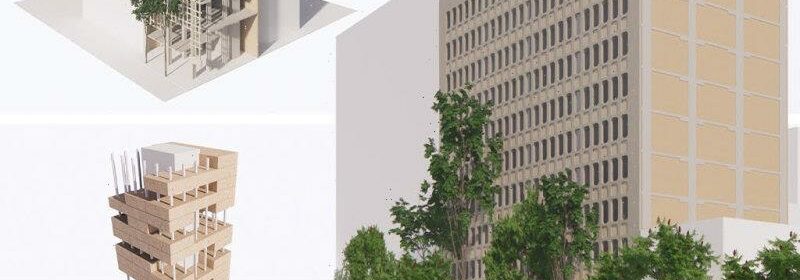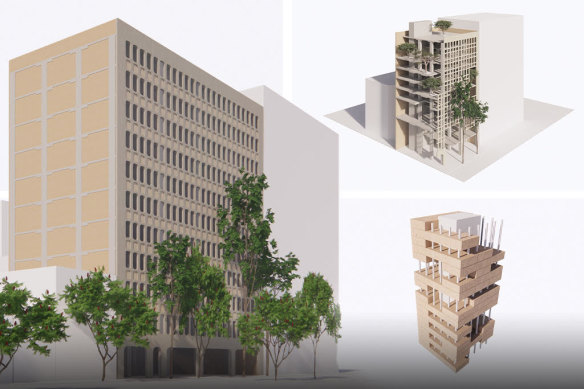Jenga style: The game theory that could reshape Melbourne’s empty offices

Key points
- The City of Melbourne wants 77 CBD buildings a year retrofitted to meet its 2040 zero-carbon goal.
- Architecture firm Woods Bagot has proposed a “Jenga-style” solution, pulling out parts of ageing buildings to add balconies, gardens and natural light.
- Property Council of Australia data shows vacancy rates for B-grade buildings in Melbourne reached 17.4 per cent in July 2022, significantly higher than that for premium buildings.
Businesses are considering a Jenga-style solution to empty and ageing “B-grade” office buildings as the City of Melbourne pushes to retrofit 77 CBD sites a year for apartments and offices.
Property Council of Australia data shows vacancy rates for older, lower-grade office buildings offering low amenity and environmental, social and governance standards in Melbourne reached 17.4 per cent in July 2022, significantly higher than that for premium buildings.
The “Jenga-model” proposition by Woods Bagot for the adaptive reuse of ageing B-grade office buildings.Credit:Woods Bagot
The City of Melbourne wants the ageing buildings retrofitted to become zero-carbon emitters, with five-star energy ratings and all-electric power. Councillors last week unanimously voted in support of a discussion paper proposing mechanisms such as reduced rates to help the municipality meet its 2040 target.
Architect Woods Bagot has proposed a Jenga approach to adaptive reuse, in reference to the popular game in which a tower is created from wooden blocks that are removed one at a time by players.
Woods Bagot interior design leaders Cassandra Fahey and Wuff Keeble said the city’s mid-century buildings, from the 1930s to 1980s, could be reimagined as a stack of blocks and regeneration could occur through pulling out pieces in key locations, letting light and social space in.
“There’s that glut of buildings that are sitting there largely in squalor with the drop ceilings and the fluoro lights,” Fahey said. “I’m not sure how happy [the tenants] are in those buildings.”
She said retrofitting the buildings Jenga-style would “kill two birds with one stone” by improving environmental credentials while making them more attractive places to live and work, bringing in natural light and ventilation.
She said many of the buildings could not be knocked down because they were heritage-protected and important to the scale and fabric of the city, making up a “middle layer”.
“If we keep demolishing that scale of building we’re going to end up with a city with these tiny Victorian things and skyscrapers … it doesn’t make sense,” she said.
Woods Bagot envisages the buildings becoming mixed-use developments with a combination of retail, office and residential space, but it faces a barrier to retrofitting them in the way property value is determined with a focus on net lettable areas.
Cassandra Fahey says Melbourne’s ageing office buildings need a refit.Credit:Woods Bagot
“Can we move beyond the real estate agent’s perception of lettable square meters and inspire building owners to embrace the new model?” Fahey said. “If you’ve increased the quality of the space, by letting natural light in, by putting in a winter garden, by putting in balconies that aren’t windy, that are carefully considered and are actually good to be on, then you can increase your square-metre rate.”
A spokeswoman for Woods Bagot said the firm was in “deep conversations” with property funds Charter Hall and AsheMorgan and co-working group Hub Australia, which all expressed interest in the model.
The game of Jenga inspired architect Woods Bagot.Credit:Woods Bagot
John Preece, chief property officer of Hub Australia, leases 40,000 square metres a year across Australian cities – a figure the business wants to increase to 100,000 square metres in the next three years.
Preece said with fewer people working in the city full-time, those who are using office space are shifting to higher-quality sites, leaving increasing numbers of buildings vacant.
“We’re not tinkering at the edges with a few buildings in Melbourne’s CBD. Potentially there is a whole raft of the market that becomes obsolete over the next four to seven years,” he said.
Preece said his key requirements when looking at buildings were that they were close to public transport, had good natural light, and complied with environmental, social and governance requirements.
He warned retrofitting ageing building stock did not come cheaply or easily.
“Most of those buildings would need to be literally stripped back to their structure,” he said. “I’m not talking about a light touch-up, it’s pulling the facade off, it’s completely gutting them all of the services, completely repositioning them, and then you put the fitout costs on top of that … we’re going to be spending about $3000 a square metre to get a really good-quality, flexible workspace.”
However, deputy lord mayor and planning lead at the City of Melbourne, Nicholas Reece, said despite the cost, retrofitting buildings was a good move from an environmental and heritage perspective.
“New heritage protections provide a second important reason for the sensitive retrofitting of buildings as part of new developments in the city,” he said. “It is far better than pulling them down.”
Charter Hall and AsheMorgan declined to comment.
The Morning Edition newsletter is our guide to the day’s most important and interesting stories, analysis and insights. Sign up here.
Most Viewed in National
From our partners
Source: Read Full Article


